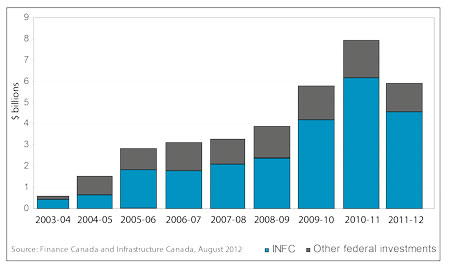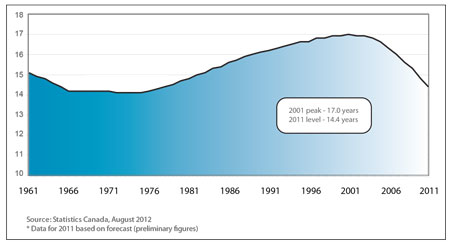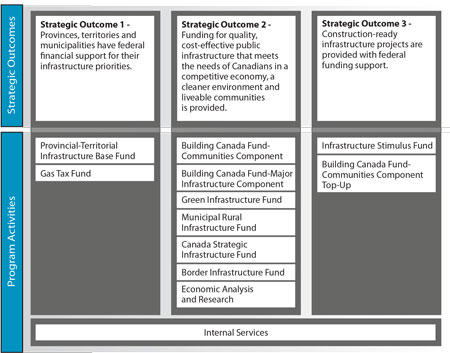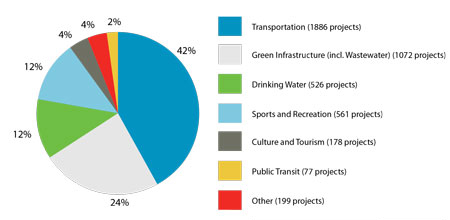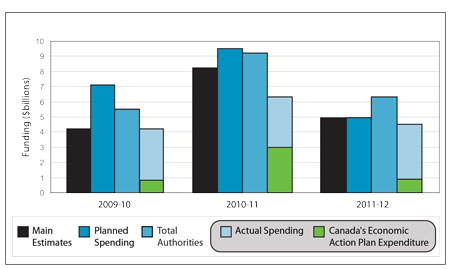Departmental Performance Report for the period ending March 31, 2012 - Section 1
PDF Version (Size: 1.34 MB)
Help on accessing alternative formats, such as PDF, PPT and ZIP files, can be obtained in the alternate format help section.
Minister's Message

As Canada's Minister of Transport, Infrastructure and Communities, I am pleased to present Infrastructure Canada's Departmental Performance Report for 2011-12. This department has played an instrumental role in helping the Government of Canada deliver timely and targeted funding that helped to create jobs and boost our economy. As a result, Canadians are enjoying the benefits of a stronger economy, a cleaner environment and more liveable communities.
Across all of its funds, Infrastructure Canada committed approximately $11 billion towards approximately 6,400 infrastructure projects since the launch of Canada's Economic Action Plan. When combined with the contributions of our funding partners, this means over $30 billion is being invested in infrastructure projects across the country. In 2011-12, we celebrated the completion of thousands of projects in communities large and small under the Infrastructure Stimulus Fund and the Building Canada Fund-Communities Component Top-Up programs, providing economic benefits that will last for years.
These stimulus programs complemented our support of projects under the Building Canada plan. Together, these investments mean Canadians are enjoying a wide range of new or improved infrastructure, such as easier and safer transportation of people and goods, improved water and wastewater treatment facilities, and new or expanded community and sports centres. These projects make our communities better places to live, work and play.
During the last fiscal year, we delivered on our commitment to provide stable and predictable funding for municipalities to support local infrastructure priorities. I am pleased to note that Parliament has passed our legislation to make Gas Tax funding permanent at $2 billion per year.
Jobs, economic growth and prosperity remain our Government's top priorities. We are working with provincial and territorial partners, leading experts and the Federation of Canadian Municipalities to develop a long-term infrastructure plan that will extend beyond the expiry of the Building Canada plan in 2014. To that end, roundtable discussions with provincial, territorial and municipal partners, and other key stakeholders are helping us to collectively understand infrastructure issues, priorities and principles.
The new plan will focus on investments that support long-term economic growth, while encouraging greater private sector involvement and public-private partnerships to generate better value for taxpayers, and to ensure affordability and sustainability over the long term. As the Government of Canada develops this new plan, we will continue to deliver significant infrastructure investments through our existing programs. We believe that modern, world-class infrastructure builds our nation for a strong future, and is helping Canada to continue to have one of the world's leading economies.
The Honourable Denis Lebel, P.C., M.P..
Minister of Transport, Infrastructure and Communities and Minister of the Economic Development Agency of Canada for the Regions of Quebec
Section I: Organizational Overview
1.1 Raison d'être
Strong, modern, world-class public infrastructure is a key factor in achieving the Government of Canada's priorities of a stronger economy, a cleaner environment, and more prosperous, safer communities. Infrastructure Canada leads the Government of Canada's efforts in addressing Canada's public infrastructure challenges.
1.2 Responsibilities
I. Overview
Infrastructure Canada is responsible for federal efforts to enhance Canada's public infrastructure through investments in provincial, territorial and municipal assets, engagement in key partnerships and the development and implementation of sound policies. Established in 2002, the Department provides funding support to provincial, territorial and municipal governments to ensure that Canadians benefit from world-class public infrastructure from coast to coast to coast.
As shown in Figure 1, federal support for provincial, territorial and municipal public infrastructure has increased significantly over the past decade, and Infrastructure Canada has been at the centre of those efforts.
Figure 1: Federal Infrastructure Support for Provincial, Territorial and Municipal Infrastructure
Over the last ten years, the unprecedented level of investment in infrastructure by all levels of government has coincided with rapid reductions in the average age of Canada's core public infrastructure. Infrastructure Canada continues to collaborate and work with its partners to help build on the success of recent investments.
Figure 2: Average Age of Core Public Infrastructure
Project Spotlight
Water treatment plant upgrades
Project location: Cornwall, Ontario

Modernizing sewage treatment to protect ground water sources
With the help of $18.5 million in federal funding, the City of Cornwall is upgrading and expanding its water treatment plant to increase capacity and add a secondary treatment process. This will reduce the risk of untreated sewage being discharged into the St. Lawrence River during heavy rainfalls. The project will also help remove Cornwall as an "area of concern" from the Canada-United States Great Lakes Water Quality Agreement.
Federal contribution: $18.5 million under the Green Infrastructure Fund
II. Programs
Infrastructure Canada's funding programs address local and regional infrastructure needs, while advancing national priorities. This, in turn, makes Canada's economy stronger, keeps people and goods on the move, and helps to make our water and air cleaner. The Department delivers funding in various ways:1
1.3 Strategic Outcomes and Program Activity Architecture (PAA)
In 2011-12, Infrastructure Canada's Program Activity Architecture (PAA) structure included three strategic outcomes and 11 active Program Activities (See Figure 3). Section II of this report provides additional detail on each Program Activity, including Internal Services, which supports all other Program Activities.
The Department's strategic outcomes reflect longer term infrastructure investments, including stable and predictable funding programs such as the Gas Tax Fund, as well as targeted programs like the Building Canada Fund. They also highlight short-term, timely and targeted programs like the Economic Action Plan funding that was provided between 2009-10 and 2011-12. Ultimately, all of our program activities result in the construction and enhancement of public infrastructure, contributing to broad federal government objectives of a competitive economy, a cleaner environment and liveable communities.
Figure 3: Program Activity Architecture (PAA)
Note: The Program Activity entitled Support for the G8 Summit is not included in this graph, nor are details included in Section II of this Report, as this Program Activity was completed in the 2010-11 fiscal year. Spending in 2010-11 is included in Section 1.6.2 for comparative information only.
1.4 Organizational Priorities
Four key organizational priorities guided the Department's work in 2011-12:
- To ensure proper financial oversight and appropriate program close-out for programs falling under the Economic Action Plan (EAP);
- To continue efficient and effective stewardship of the longer term infrastructure programs and projects;
- To implement the results of Infrastructure Canada's 2010 Strategic Review; and
- To support Public Service Renewal and improve People Management.
Summary of Progress Against Priorities
Priority 1
| Priority | Type2 | Strategic Outcome(s) and/or Program Activity(ies) |
|---|---|---|
| Ensure proper financial oversight and appropriate program close-out for programs under the Economic Action Plan (EAP). | Previously committed to | Strategic Outcome 3: Construction-ready infrastructure projects are provided with federal funding support. |
- Throughout 2011-12, the Department's strong financial management helped to support the successful completion of projects under the two key Economic Action Plan programs: the Infrastructure Stimulus Fund (ISF) and the Building Canada Fund-Communities Component Top-Up (BCF-CC Top-Up).
- Over 97 percent of ISF and BCF-CC Top-Up projects were completed by October 31, 2011. The majority of remaining projects are anticipated to be completed shortly by proponents.
- The Department's strong financial oversight was recognized by the Office of the Auditor General in its second audit of Canada's Economic Action Plan (Auditor General's Fall 2011 report). The interim Auditor General found that the Department had monitored the progress and spending of ISF projects, and made appropriate adjustments in a number of cases, including implementing the Government of Canada decision to extend the deadline for project completion.
Priority 2
| Priority | Type | Strategic Outcome(s) and/or Program Activity(ies) |
|---|---|---|
| Efficient and effective stewardship of the longer term infrastructure programs and projects. | Ongoing |
Strategic Outcome 1: Provinces, territories and municipalities have federal financial support for their infrastructure priorities. Strategic Outcome 2: Funding for quality, cost-effective public infrastructure that meets the needs of Canadians in a competitive economy, a cleaner environment and liveable communities is provided. |
- During 2011-12, the Department continued to effectively manage and implement its longer term programs. With the majority of the funds from these programs already allocated, the departmental focus was on appropriate program management control frameworks, along with documentation, monitoring and reporting strategies. For example, the Department ensured that claims were properly submitted by project partners, and then quickly but thoroughly reviewed and processed these claims for payment.
- Infrastructure Canada is continuing its strong performance in monitoring our programs by ensuring that key requirements of the Treasury Board Policy on Internal Audit are met. The Department continues to test the effectiveness of its internal controls through risk-based, ongoing monitoring, and by engaging its Departmental Audit Committee on internal controls of financial reporting assessment work.
- The Department continues to strengthen stewardship of programs and projects through Financial Management and Control frameworks, including improved budgeting and forecasting practices, the framework for financial management systems, and high-quality departmental financial statements and quarterly financial reports.
Priority 3
| Priority | Type | Strategic Outcome(s) and/or Program Activity(ies) |
|---|---|---|
| Implement the results of Infrastructure Canada's 2010 Strategic Review. | New |
Strategic Outcome 1: Provinces, territories and municipalities have federal financial support for their infrastructure priorities. Strategic Outcome 2: Funding for quality, cost-effective public infrastructure that meets the needs of Canadians in a competitive economy, a cleaner environment and liveable communities is provided. |
- As part of the 2010 Strategic Review process, Infrastructure Canada systematically reviewed direct program spending and operating costs to find efficiencies and reallocate funds in support of the government's overarching strategic review objective of management excellence and fiscal responsibility.
- As a result of its review, Infrastructure Canada identified opportunities to focus on core priorities and deliver its programs and services more efficiently, while continuing to deliver government investments in Canada's public infrastructure.
- Savings identified total $124.5 million over a three-year period, ending in 2013-14. Implementation of these reductions began in 2011-12, amounting to $51.8 million during the fiscal year.
Priority 4
| Priority | Type | Strategic Outcome(s) and/or Program Activity(ies) |
|---|---|---|
| Support Public Service Renewal and improve People Management. | Ongoing |
Strategic Outcome 1: Provinces, territories and municipalities have federal financial support for their infrastructure priorities. Strategic Outcome 2: Funding for quality, cost-effective public infrastructure that meets the needs of Canadians in a competitive economy, a cleaner environment and liveable communities is provided. |
- In 2011-12 Infrastructure Canada continued to make progress in addressing the priorities set out in the Public Service Renewal Action Plan. The Department ensured employees were engaged and motivated to excel, and that they received the proper support and development opportunities. In addition, the Department updated its Integrated Business and Human Resources Plan, developing and implementing action plans to meet our Human Resources priorities and challenges.
1.5 Risk Analysis
1.5.1 Risk Analysis Approach
Infrastructure Canada systematically manages a variety of risks as it delivers its funding programs. As risks emerge and change, the Department continues to apply a comprehensive approach to actively identify, assess and manage risks at the strategic, operational, program and project levels. This approach includes regularly identifying internal and external risk factors, and engaging the Department's executives to identify and assess potential key risks and then to develop adequate responses. This information is then captured in the Department's Corporate Risk Profile and semi-annual update reports. Risk management is fully integrated into Infrastructure Canada's decision-making processes, and the lessons learned from these regular risk update exercises are part of the Department's culture at all levels, enhancing program efficiency as well as stewardship.
1.5.2 Departmental Risks
The most recent (Fall 2011) Corporate Risk Profile update demonstrated an overall reduction in departmental risks. The updated profile lists eight risks, down from eleven in 2010. Also, the overall likelihood and potential impact decreased in 2011, due in large part to the winding down of programs under Canada's Economic Action Plan, as well as the Department's strong and integrated risk management practices.
The three key departmental risks identified in the 2011-12 Report on Plans and Priorities followed the same downward trend in terms of their overall significance as a result of the implementation of sound risk responses.
Flexibility of Information Management and Information Technology
The Department established a senior executive (Assistant Deputy Minister-level) Investment Planning Committee to oversee Information Management (IM) and Information Technology (IT) project investments. This Committee ensures investments are in line with departmental priorities, and allows the Department to upgrade and maintain legacy systems, and provide IT solutions that are usable, flexible and effective. The Department also strengthened the Shared Information Management System for Infrastructure (SIMSI) governance structure to ensure that IT development continues to meet business and reporting needs. This improved governance structure ensures appropriate and timely funding is directed to support departmental priorities.
Provision of all Economic Action Plan (EAP) Funds Within Established Timeframes
In order to ensure that projects met the deadlines for temporary infrastructure programs (Infrastructure Stimulus Fund and Building Canada Fund-Communities Component Top-Up), Infrastructure Canada implemented a risk-based monitoring strategy. This included regular (quarterly or bi-monthly) reporting, invoice verification, targeted on-site visits and project compliance audits.
In addition, Service Level Agreements with Federal Delivery Partners and Contribution Agreements with proponents clearly established requirements pertaining to project reporting. Together, the Agreements and monitoring strategy allowed for the efficient delivery of infrastructure stimulus funding. At the same time, the Department prudently but quickly processed claims, ensuring costs claimed were eligible for reimbursement, identifying any ineligible costs and, if necessary, withheld payment until further details were provided by proponents.
Adaptability of Human Resources Capacity and Capability
A new challenge in 2011-12 was the need for departmental staff to adapt from providing front-end services and support (e.g. project review, assessment and approval), to supporting the delivery and close-out of the programs under the Economic Action Plan (e.g., the monitoring and processing of claims). To help deal with this challenge, the Department provided several assignment opportunities to employees, giving staff the chance to gain new skills and experience, while allowing the department to reallocate people to priority areas. The Department's talent management strategy also developed employees' skills, leading to increased flexibility to deal with new challenges. Finally, the Department streamlined business processes and more efficiently administered our programs.
1.6 Summary of Performance
During 2011-12, Infrastructure Canada continued to support Canada's economy, working with partners towards completing the delivery of projects under two key Economic Action Plan (EAP) programs: the Infrastructure Stimulus Fund and the Building Canada Fund-Communities Component Top-Up. In the final year of implementing these programs, the Department shifted its efforts from reviewing and approving projects and committing funds, to providing appropriate management, due diligence and oversight as the Department paid claims and closed out successful projects. The Department dedicated significant resources to ensure that all financial claims received from proponents were processed accurately and efficiently and reimbursed quickly.3
While a significant focus was on winding down the EAP programs, Infrastructure Canada also continued to work closely with partners across Canada to make key infrastructure investments through longer-term programs, including those under the seven-year Building Canada plan, the Gas Tax Fund (now permanent with an allocation of $2 billion per year) and a number of sunsetting programs. Under the Provincial-Territorial Infrastructure Base Fund, the Department continued to approve projects/initiatives and Capital Plans, and made key investments in nationally and regionally significant projects that benefit all Canadians.
For example, in 2011-12, under the Building Canada Fund-Communities Component (BCF-CC) and the Building Canada Fund-Major Infrastructure Component (BCF-MIC), Infrastructure Canada committed $119 million to new projects, leveraging total investment of more than $308 million. In addition, as of March 31, 2012, eight provinces and territories had fully committed their balance of funds available through the Provincial-Territorial Infrastructure Base Fund. Across Canada, almost 89 percent of the overall $2.3 billion program has been committed.
Overall, 2011-12 was another successful year for the Department, with nearly $4.5 billion in infrastructure funding flowed to our partners.
Section II: Analysis of Program Activities by Strategic Outcomes provides a summary of Infrastructure Canada's performance targets by Program Activity, as set out in the 2011-12 Report on Plans and Priorities. Infrastructure Canada works in partnership with provinces, territories and municipalities in order to meet these annual performance targets. Annual results are affected by the performance of its partners, for example project timelines and forecasted completion and spending are based on project proponent's schedules.
Overall, the Department fully met or exceeded more than half of all performance targets (23 of 40) and significantly met six targets. Detailed information on performance indicators, results achieved, analysis and other information by Program Activity is provided in Section II.
1.6.1 Economic Action Plan Performance Summary
LOOKING BACK AT CANADA'S ECONOMIC ACTION PLAN
Reliable public infrastructure support has always been a cornerstone of Canada's economic growth and prosperity. In 2009, when the global economic crisis hit, the Government of Canada moved quickly to increase its investments in infrastructure in order to stimulate the economy and create jobs in the short term while providing lasting benefits to Canadians.
Under the Economic Action Plan (EAP), the Government of Canada worked with key partners to increase cooperation and reduce red tape. Notably, infrastructure funding under existing Building Canada programs was accelerated, project approvals were expedited and new money was provided for "shovel-ready", short-term projects.
Combined, these efforts allowed new and existing infrastructure funding to be rapidly committed to thousands of infrastructure projects across Canada. Much of this funding was prioritized for shovel-ready projects that could generate additional investment from other levels of government. These investments stimulated the economy and supported families and communities when they needed it most.
In delivering unprecedented, timely and temporary investments in infrastructure, Infrastructure Canada was responsive and responsible. According to a report from the Auditor General of Canada, Infrastructure Canada balanced speed of implementation with effective stewardship of stimulus funding. The broad range of completed projects, from water facilities to green infrastructure to local roads, has given Canadians and communities better public infrastructure, provided local economic opportunities and strengthened the national economy and standard of living in communities, ensuring a legacy of quality infrastructure for future generations.
Two Key Infrastructure Funds
The EAP provided a variety of important economic stimulus measures delivered by numerous federal organizations. At Infrastructure Canada the two most prominent initiatives were the new Infrastructure Stimulus Fund and the Building Canada Fund – Communities Component Top-Up. Combined with funding from provinces, territories and municipalities, Infrastructure Canada's EAP programming helped communities quickly build and improve much-needed local infrastructure. Not only were the projects under these programs rolled out quickly and responsibly, almost all were completed within planned timeframes.
These two new stimulus programs not only supported employment and economic activity in all regions of the country, but also contributed to national priorities of a cleaner environment and more liveable communities. Infrastructure Canada delivered short-term funding to modernize a broad range of infrastructure, including roads, bridges, public transit, parks and wastewater and water treatment facilities.
Funding by Major Category*
* Infrastructure Stimulus Fund – 3,973 projects; Building Canada Fund-Communities Component – 526 projects
1.6.2 Financial and Human Resources
Infrastructure Canada's financial and human resources information over the reporting period are summarized in the two tables that follow.
Table 1: 2011-12 Financial Resources (in $ thousands)
| Planned Spending | Total Authorities | Actual Spending |
|---|---|---|
| 4,881,172 | 6,304,315 | 4,540,110 |
Table 2: 2011-12 Human Resources (full-time equivalents [FTE])
| Planned | Actual | Difference |
|---|---|---|
| 330 | 357 | -27 |
Infrastructure Canada's full-time equivalents (FTEs) are managed flexibly. Employees are reallocated as needed during the year to meet the needs of funding programs, operational requirements, and other government priorities. Operating funding is also allocated to program administration on a similar basis. Infrastructure Canada does not have a regular and ongoing level of funding for departmental operational costs (e.g. salaries, operations and maintenance — "A-Base"). Instead, funding for Infrastructure Canada's operating requirements has traditionally been sourced and approved from its funding programs. Operational funding fluctuates based on the actual oversight and management necessary for programs.
Project Spotlight
Resolute Bay Water System
Project location: Resolute Bay, Nunavut

For more than 30 years, residents of Resolute Bay have relied on heated utility corridors to bring fresh water to their homes and businesses. These "utilidors" also facilitate the removal of wastewater.
With the existing utilidor system reaching the end of its lifespan, the Territory will be putting a portion of its Provincial-Territorial Infrastructure Base Fund allocation towards replacing it. This will help ensure that residents continue to have fresh water and suitable wastewater removal for years to come. It will also support Nunavut's continued growth and economic stability.
Funding: In total, Nunavut is receiving more than $182 million under the Provincial-Territorial Infrastructure Base Fund.
1.6.3 Program Activities by Strategic Outcome and Actual Spending
The following table summarizes the achieved results of the program activities, the actual spending under each activity, as well as the alignment of these activities to the Government of Canada outcomes. Infrastructure Canada works in partnership with provinces, territories and municipalities in order to meet these annual performance targets. As such, annual results are affected by both the performance of Infrastructure Canada, as well as its provincial, territorial and municipal partners. The Internal Services Program Activity is also presented in this table; the Program Activity supports the entire department in meeting Government of Canada outcomes.
Table 3: Performance Summary (Program Activities by Strategic Outcome)4
Strategic Outcome 1: Provinces, territories and municipalities have federal financial support for their infrastructure priorities.
| Performance Indicators | Targets | 2011-12 Performance |
|---|---|---|
| Total funds transferred by the federal government to provinces, territories and municipalities for their infrastructure priorities.5 | Flow 100% of all planned spending under Strategic Outcome 1 in FY2011-12 |
Result: 102% Under the Provincial-Territorial Infrastructure Base Fund and Gas Tax Fund, the Government of Canada flows funds to jurisdictions following receipt and federal acceptance of Expenditure Reports and/or Capital Plans. In 2011-12, the Department flowed $2.39 billion under the two funds (over 102% of planned spending) to provinces, territories and municipalities.6 Together, since the inception of the funds, approximately $8.7 billion under the Gas Tax Fund and more than $1.6 billion under the Provincial-Territorial Infrastructure Base Fund has provided stable and predictable funding to support the construction of provincial/territorial and municipal infrastructure. |
| Program Activity | 2010-11 Actual Spending | 2011-12 | Alignment to Government of Canada Outcomes | |||
|---|---|---|---|---|---|---|
| Main Estimates | Planned Spending | Total Authorities | Actual Spending | |||
| Provincial-Territorial Infrastructure Base Fund | 437,548 | 347,375 | 347,375 | 391,125 | 188,695 | Strong Economic Growth |
| Gas Tax Fund | 1,752,697 | 1,975,952 | 1,975,952 | 2,329,381 | 2,206,246 | Strong Economic Growth |
| Sub-Total: | 2,190,245 | 2,323,327 | 2,323,327 | 2,720,506 | 2,394,942 | |
Strategic Outcome 2: Funding for quality, cost-effective public infrastructure that meets the needs of Canadians in a competitive economy, a cleaner environment and liveable communities is provided.
| Performance Indicators | Targets | 2011-12 Performance |
|---|---|---|
| Total funding provided to partners for targeted and strategic public infrastructure projects.7 |
Flow 100% of all planned spending under Strategic Outcome 2 in FY2011-12. Longer Term: Transfer $8.5 billion in federal funding to project recipients from 2009-10 to 2012-13. |
Result: 52% Through the seven program activities under this Strategic Outcome, Infrastructure Canada spent $1.32 billion, providing funding for provincial infrastructure and important local infrastructure for cities and communities across the country. Actual Spending in 2011-12 was lower than planned. This is the result of a number of factors including lower than anticipated project costs, projects cancelled by proponents, and project delays resulting from inclement weather, technical and other construction-related complexities that caused numerous construction delays. In addition, many of the programs under this Strategic Outcome provide significant funding for large, complex projects. It is typical for these projects to require a significant amount of upfront planning, design and procurement. These processes may occur, in whole or in part, after funding commitments are announced. As a result, there is often a period of time that will pass between project announcements and when construction starts. It is also noted that actual spending lags behind the actual rate of construction of projects since recipients are reimbursed only once claims are submitted, even though eligible costs may have already been incurred. |
| Partner contributions expressed as percentage of federal funding committed. | 100% |
Result: 233% Since the inception of all programs, more than $30.1 billion has been leveraged from federal funding committed ($12.9 billion) for projects under BCF-CC, BCF-MIC, GIF, CSIF, MRIF and BIF. |
| Program Activity | 2010-11 Actual Spending | 2011-12 | Alignment to Government of Canada Outcomes | |||
|---|---|---|---|---|---|---|
| Main Estimates | Planned Spending | Total Authorities | Actual Spending | |||
| Building Canada Fund-Communities Component | 225,825 | 323,391 | 323,391 | 300,850 | 213,884 | Strong Economic Growth |
| Building Canada Fund-Major Infrastructure Component | 407,499 | 1,270,430 | 1,270,430 | 1,225,232 | 759,828 | Strong Economic Growth |
| Green Infrastructure Fund | 35,430 | 431,084 | 431,084 | 390,712 | 30,274 | Clean and Healthy Environment |
| Canada Strategic Infrastructure Fund | 336,451 | 378,791 | 378,791 | 480,998 | 188,382 | Strong Economic Growth |
| Municipal Rural Infrastructure Fund | 146,646 | 47,226 | 47,226 | 128,348 | 88,043 | Strong Economic Growth |
| Border Infrastructure Fund | 67,881 | 51,738 | 51,738 | 44,355 | 35,042 | Strong Economic Growth |
| Economic Analysis and Research | 1,750 | 10,817 | 10,817 | 1,956 | 3,143 | Innovative and Knowledge-Based Economy |
| Sub-Total: | 1,221,482 | 2,513,477 | 2,513,477 | 2,572,450 | 1,318,595 | |
Strategic Outcome 3: Construction-ready infrastructure projects are provided with federal funding support.
| Performance Indicators | Targets | 2010-11 Performance |
|---|---|---|
| Total amount of eligible costs incurred for construction-ready public infrastructure projects. | 95% of eligible costs incurred by October 31, 2011. |
Result: 97% 98% by March 31, 2012 |
| Percentage of projects under the Economic Action Plan that are substantially completed by the end of program, out of total number of projects approved. | 95% of approved EAP projects are substantially completed. |
Result: 97% 4,452 Economic Action Plan projects were substantially completed within program timelines, representing over 97% of the planned target. 98% - 4,499 Economic Action Plan projects were substantially completed by March 31, 2012. |
| Funding leveraged from partners, as a percentage of federal funding, for construction-ready public infrastructure projects. | 100% over the life of EAP programs (2009-10 to 2011-12). |
ISF Result: 150% (approximately $6 billion leveraged) BCF-CC Top-Up Result: 215% ($1 billion leveraged) Throughout the year, the Government of Canada remained committed to timely completion of stimulus projects, while preparing to return to a balanced budget. Through the ISF and BCF-CC Top-Up, the Government provided more than $4 billion of federal funding, leveraging approximately $7 billion in infrastructure investment from partners. |
| Program Activity | 2010-11 Actual Spending | 2011-12 | Alignment to Government of Canada Outcomes | |||
|---|---|---|---|---|---|---|
| Main Estimates | Planned Spending8 | Total Authorities9 | Actual Spending | |||
| Infrastructure Stimulus Fund | 2,482,489 | 2,400 | 2,400 | 803,140 | 634,927 | Strong Economic Growth |
| Building Canada Fund-Communities Component Top-Up | 303,739 | 0 | 0 | 163,000 | 136,122 | Strong Economic Growth |
| Support for the G8 Summit (2010)10 | 4,571 | 0 | 0 | 0 | 0 | Strong Economic Growth |
| Sub-Total: | 2,790,799 | 2,400 | 2,400 | 966,140 | 771,049 | |
Internal Services: Underpins and supports the entire Department in meeting Government of Canada outcomes.
| Program Activity | 2010-11 Actual Spending | 2011-12 | |||
|---|---|---|---|---|---|
| Main Estimates | Planned Spending | Total Authorities** | Actual Spending | ||
| Internal Services | 49,265 | 41,969 | 41,969 | 45,219 | 55,525 |
| Sub-Total: | 49,265 | 41,969 | 41,969 | 45,219 | 55,525 |
| Total Actual Spending: | 6,251,791 | 4,881,172 | 4,881,172 | 6,304,315 | 4,540,110 |
** Excludes amount appropriated to Shared Services Canada
1.7 Contribution to the Federal Sustainable Development Strategy
The Federal Sustainable Development Strategy (FSDS) outlines the Government of Canada's commitment to improve the transparency of environmental decision-making. The strategy outlines key strategic environmental goals and targets, and ensures that they are considered in decision-making.
Although Infrastructure Canada is not one of the 27 departments required to table a Departmental Sustainable Development Strategy or to report on its contribution to the FSDS, it continues to play an important role in helping create a more sustainable future.
The Department's broad range of infrastructure programs supports thousands of projects across Canada that contribute to a cleaner environment in areas such as drinking water, wastewater, clean energy, public transit and brownfield redevelopment. Many of these infrastructure investments directly support two of the FSDS Themes:
- Maintaining Water Quality and Availability
- Addressing Climate Change and Air Quality
Beyond providing funding through federal infrastructure funding programs, Infrastructure Canada's measures support The FSDS's Theme 4, Shrinking the Environmental Footprint – Beginning with Government. The Department continues to implement its recent Greening Action Plan, which includes measures in green procurement, waste and energy reductions, and awareness and promotion. More details on our green procurement initiatives can be found in the Supplementary Information Tables on Greening Government Operations.
Strategic Environmental Assessment (SEA)
The Cabinet Directive on the Environmental Assessment of Policy, Plan and Program Proposals11 states that an SEA is required when the implementation of a proposal submitted to an individual Minister or Cabinet for approval may result in important environmental effects, either positive or negative. To ensure that the Cabinet Directive is being met, the Department undertakes a preliminary scan to identify the potential for important environmental effects when preparing a Memorandum to Cabinet and for other policy, plan and program initiatives, as appropriate. Should the potential for significant environmental impacts be identified and/or there is a high level of uncertainty or risk associated with the proposal, a Strategic Environmental Assessment is carried out. In 2011-12, no important environmental effects, either positive or negative were identified through any of the preliminary scans completed. As a result, no Strategic Environmental Assessments were required.
1.8 Expenditure Profile
1.8.1 Spending Trends
In 2011-12, Infrastructure Canada spent $4.5 billion on infrastructure investments under its programs to meet the expected results of its Program Activities and contribute to its Strategic Outcomes.
Figure 4 represents the Department's planned and actual spending profile from 2009-10 to 2011-12. Spending related to the Economic Action Plan (EAP) started in 2009-10 and continued until 2011-12 (with exception of the Green Infrastructure Fund, which currently extends to 2013-14).
Departmental Spending Trend and the Economic Plan (EAP)
Investment in strong, modern, world-class public infrastructure is a key element in achieving the Government of Canada's priorities of a stronger economy, a cleaner environment and more liveable communities. In 2011-12, the Department's $4.5 billion in spending supported the construction of public infrastructure, strengthening the economy in many sectors and regions across the country.
1.8.2 Variations in Program Spending Trends
In 2011-12, the Department focussed on the closing out of two of its key programs under the EAP: the Infrastructure Stimulus Fund and the Building Canada Fund-Communities Component Top-Up. At the same time, the Department continued to implement its longer term programs under the Building Canada plan.
1.9 Estimates by Vote
For information on Infrastructure Canada's Votes and/or statutory expenditures, please see the 2011-12 Public Accounts of Canada (Volume II) publication. An electronic version of the Public Accounts is available on the Public Works and Government Services Canada website.
- Date modified:
